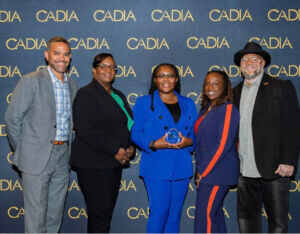ERGs: From Feel-Good to Business Impact

𝐴𝑑𝑖𝑒𝑛𝑡 𝐴𝑓𝑟𝑖𝑐𝑎𝑛 𝐴𝑛𝑐𝑒𝑠𝑡𝑟𝑦 𝐵𝑢𝑠𝑖𝑛𝑒𝑠𝑠 𝑅𝑒𝑠𝑜𝑢𝑟𝑐𝑒 𝐺𝑟𝑜𝑢𝑝 (𝐴𝐴𝐵𝑅𝐺) -- 𝑅𝑒𝑐𝑖𝑝𝑖𝑒𝑛𝑡 𝑜𝑓 2025 𝐼𝑚𝑝𝑎𝑐𝑡 𝐴𝑤𝑎𝑟𝑑 𝑓𝑜𝑟 𝐸𝑅𝐺 𝐸𝑥𝑐𝑒𝑙𝑙𝑒𝑛𝑐𝑒
Part 1 of 3: Why good intentions aren't enough—and how to build what comes next
This is the first in a three-part series exploring how ERG leaders can move from good intentions to exceptional impact. In this post, we'll examine the evolution opportunity facing ERGs today. Next, we'll dive into the three pillars that separate transformational ERGs from social groups. And in the final post, we'll outline the practical path forward to sustainable success.
Here's what I've learned through years of working with passionate ERG leaders and committed executives: Good intentions are the essential starting point for great ERGs, but they're not the finish line. Many organizations have built strong ERG communities while missing opportunities to unlock their full potential as drivers of workplace transformation and competitive advantage.
The Opportunity
Let me share a pattern I see across our industry. Companies launch ERGs with genuine enthusiasm and significant investment. Leadership champions the initiative. They provide budgets and meeting spaces. The initial energy is incredible.
Fast forward eighteen months: dedicated ERG leaders are working harder than ever, but they're starting to feel the weight of trying to drive change while managing their primary roles. Members are engaged but wondering how their participation connects to career growth. Meanwhile, leadership is asking important questions about impact and sustainability.
This isn't a failure—it's a natural evolution point that signals readiness for the next level.
Through our work with CADIA members, we've discovered that the most successful ERGs aren't just building community (though that's important). They're creating measurable workplace improvements, accelerating career advancement, and delivering business value that strengthens the entire organization.
The Real Challenges (And Why They're Solvable)
ERG leaders are carrying a heavy load. They're passionate about making a difference, but they're also managing their primary roles, attending meetings, and organizing initiatives. Many tell me they volunteered to create change, and they want to make sure their efforts translate into meaningful impact.
Leadership interest is there, but clarity is needed. Executives want to support ERGs and often ask: "How do we help people step into leadership roles? How do we make participation rewarding rather than burdensome?"
The sustainability question. Organizations are looking for ways to create systems that don't depend on a few dedicated individuals carrying everything. They want to build momentum that grows rather than depletes energy.
And here's the exciting part: When organizations address these challenges systematically, ERGs become powerful drivers of both individual advancement and business success.
The question isn't whether your people are ready for greater impact—they are. The question is how quickly we can evolve our systems to support their potential and create the workplace transformation our industry needs.
In Part 2, we'll explore the three non-negotiable pillars that separate transformational ERGs from well-intentioned social groups—and discover the practical frameworks that forward-thinking leaders are using to create sustainable impact.
Article exclusively written for cadia.org
Authored by Cheryl Thompson with AI assist
